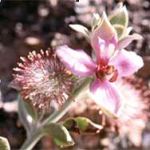| Common Name: |
Ratanhia |
| Other Names: |
Rhatany, Mapato |
| Botanical Name: |
Krameria lappacea syn. K. triandra |
| Genus: |
Krameria |
| Family: |
Krameriaceae |
| Native Location: |
Peru, W slopes of the Andes at 915-2785m (3000-9000ft) |
| Cultivation: |
Well-drained, sandy or stony soil in sun. |
| Propagation: |
This species does not appear to be in cultivation. |
| Harvest: |
Roots are lifted from wild plants and dried for use in tinctures and dry extracts. |
| Height: |
50-90cm (20-36in) |
| Width: |
60cm-1.2m (2-4ft) |
| Hardiness: |
Min. 5-10°C (41-50°F) |
| Parts Used: |
Roots, Various pars of the entire plant, frequently differing by country and culture. |
| Chemical Constituents: |
Calcium Oxalate
Gum
Lignin
N-Methyltyrosine
Saccharine
Starch
Tannins
|
| Properties: |
A strongly astringent herb that checks bleeding, controls discharges and diarrhea, and encourages healing. |
| Known Effects: |
Anti-Inflammatory
Helps treat canker sores
|
| Possible Additional Effects: |
May treat sore throat
May treat hemorrhoids
May treat chronic bowel inflammations
May treat diarrhea
Potential mouthwash
|
| Medicinal Uses: |
Internally for diarrhea, hemorrhage, and heavy menstruation. Externally for vaginal discharge, hemorrhoids, chilblains, wounds, gingivitis, and pharyngitis. |
| Warnings and Precautions: |
Don't take if you:
Are pregnant, think you may be pregnant, or plan pregnancy in the near future
Have any chronic disease of the gastrointestinal tract, such as stomach or duodenal ulcers, reflux esophagitis, ulcerative colitis, spastic colitis, diverticulosis, or diverticulitis
Consult your doctor if you:
Take this herbs for any medical problem that doesn't improve in 2 weeks (There may be safer, more effective treatments.)
Take any medicinal drugs or herbs, including laxatives, cold and cough remedies, antacids, vitamins, minerals, amino acids, supplements, other prescription or non-prescription drugs
Pregnancy:
Dangers outweigh any possible benefits. Don't use.
Breastfeeding:
Dangers outweigh any benefits. Don't use.
Infants and Children:
Treating infants and children under 2 with any herbal preparation is hazardous.
Others:
None are expected if you are beyond childhood, under 45, not pregnant, basically healthy, take it for only a short time and do not exceed manufacturer's recommended dose.
Storage:
Store in cool, dry area away from direct light, but don't freeze.
Store safely away from children.
Don't store in bathroom medicine cabinet. Heat and moisture may change the action of the herb.
Safe Dosage:
Consult your doctor for the appropriate dose for your condition.
|
| Adverse Reactions, Side Effects, or Overdose Symptoms: |
| Signs and Symptoms |
What to Do |
|
| Diarrhea |
Discontinue. Call doctor immediately. |
| Kidney damage characterized by blood in urine, decreased urine flow, swelling of hands and feet |
Seek emergency treatment. |
| Nausea or Vomiting |
Discontinue. Call doctor immediately. |
|
| Economic Uses: |
Added to port wine to raise astringency, and also to oral hygiene products. |
| Bibliography: |
Encyclopedia of Herbs by Deni Brown Copyright © 1995, 2001 Dorling Kindersley Limited. Pp 249-250
Vitamins, Herbs, Minerals & Supplements The Complete Guide by H. Winter Griffith, MD Copyright©1998 Fisher Books. pp. 427-428. |

